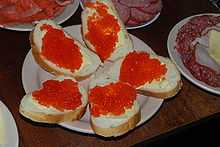Butterbrot
| Butterbrot | |
|---|---|
 | |
| Type | Bread |
| Place of origin | Germany |
| Main ingredients | Bread, butter |
|
| |


The German word "Butterbrot" (literally: butterbread = bread with butter) describes a slice of bread topped with butter. The words in formal and colloquial German and the different dialects for butterbrot (different from "belegtes Brot" - with cheese, sausages etc.), simply "Brot" (bread), "Butterstulle", "Stulle", "Schnitte" (all three Northeast/Berlin dialect), "buterbrodas", "Bütterken" (Rheinland dialect) to "Bemme" (Saxon dialect) or "Knifte" (Ruhr dialect). Russian adopted the term "Butterbrot" to refer to sandwiches in general, see Russian: Бутерброд. Although it is increasingly replaced by other foods, it remains a common staple food in Germany. Since 1999, the last Friday in the month of September was made the day of butterbrot by the Marketing Organization of German Agricultural Industries.[1]
Comparison with sandwiches
A butterbrot is commonly a single slice of bread and one "ingredient" on top of the butter or margarine. For breakfast, this ingredient tends to be sweet and can be marmalade, jam, honey, chocolate spread, hazelnut spread, peanut butter, sprinkles, vlokken, or muisjes. For dinner (in Germany, people traditionally eat only one cooked meal per day) or as boxed lunch, and often also for breakfast, the butterbrot is eaten with something savory, usually a single slice of cold meat or cheese, or sometimes spreads etc. Boxed lunch butterbrot can be folded for easier handling and as such resembles the sandwich. In Austria butterbrot only refers to a slice of bread with butter. If a topping is added it is named after the topping (e.g. Käsebrot "cheese bread", Wurstbrot "sausage bread").
The derivatives of the British sandwich and the butterbrot of the German-speaking countries differ in some ways: The butterbrot is usually made from the typical bread types of German-speaking countries, which are much firmer than English bread. One popular type is Graubrot (grey bread), which has a sour taste, due to the use of sourdough as a leavening agent, and contains rye. As Graubrot requires the culture of rye, which implies sourdough, and widespread dairy farming, most south-/western-European countries came to prefer other kinds of (mainly white) breads (baguette, ciabatta, toast etc.). Graubrot exists in dozens of varieties with respect to taste, shape, color, etc. Another popular bread type is Schwarzbrot (black bread), which is even firmer and of darker color; again many different varieties exist.
Possibly even more important are differences with respect to what is eaten on top of a butterbrot or in a sandwich. Although exceptions exist, a butterbrot is commonly not expanded the way sandwiches are. One slice of cheese and one or (in case of thin slices) maybe two slices of cold meat are commonly considered sufficient; adding lettuce or even onions, ketchup etc. is virtually unheard of. Also the ratio of bread and "topping" is relatively constant; thick sandwich fillings have almost no equivalent for the butterbrot. If more than one topping is added then it is called belegtes Brot/Brötchen ("topped bread"). These are common at buffet tables.
German speakers differentiate between the German-style butterbrot and the British-style sandwich by using the English word "sandwich" for the latter. As the English language does not contain both words, English speakers commonly describe both butterbrot and sandwich with the word sandwich.
Decline
The butterbrot has been replaced gradually in the last 40 years by muesli, breakfast cereals or toast for breakfast and take-away bakery products during daytime.
Nonetheless, it remains a common staple food among many Germans. In addition, for many Germans, especially families, it remains popular in the evening. It is also eaten a lot on hiking trips. In many parts of Germany the butterbrot is still very common for second breakfast at school or work (much more often eaten than, for example, fast food).
Usually in September every year, the Central Marketing Society for German Agriculture (CMA, the agricultural industry's lobby group) declares a "day of the German Butterbrot". The 8th Butterbrot day's motto in 2006 was: "Re-Experience Enjoyment".[2] The celebration is one of many "Days of..." and not very well known in Germany.
Urban legends
Butterbrots and their variants are said to always fall to the floor (and especially on a fuzzy carpet) with the buttered side downwards (see: Murphy's law). A common explanation is that the top side is usually heavier than the bottom side. This applies more to Nutella/jam breads than cheese/meat breads. Another is tied to the common height of tables. The subject has been researched by various sources, e.g. the famous children's series Die Sendung mit der Maus, and the scientific German TV series Quarks & Co. It is often joked about what would happen if you tie a butterbrot to the back of a cat, in the same manner that hypothetical buttered toast attached to the back of a cat is sometimes joked about, with it being debated whether the feline would still honour the popular axiom, that a cat "always lands on its feet", or if the butterbrot would be "stronger", making the cat fall on its back — alternatively, it is sometimes humorously suggested that the cat would simply levitate, as it would be unable to satisfy both criteria for landing.
See also
References
- ↑ "Tag des Deutschen Butterbrotes". berlinonline.de. Retrieved 18 October 2010.
- ↑ http://www.presseportal.de/pm/7595/1054420/cma
External links
- German Food Guide: Das Butterbrot, The German Sandwich
- The butterbrot experiments and the different lines of thought (German)
- Resume of the experiments in Quarks & Co (German)
- Cartoon Translation: "Cats always land on their feet and butterbrots always land on the top side, what could be more interesting than strapping a Butterbrot on top of a cat and let them fall together." – "Poor butterbrot." This experiment refutes the claim that butterbrots always land on the top side.
| ||||||||||